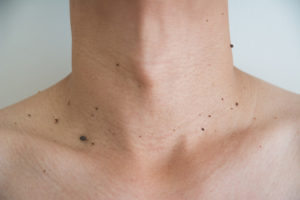
Let’s face it, it’s rare that we give any prolonged thought to any moles we may have. Much like freckles, birthmarks and other spots, moles have come to simply occupy a space on our skin. Throughout time, we tend to forget that they’re even there as our bodies change and grow. Every now and then, a mole can change in ways that raise concern. While it’s easy to dismiss a new spot or an old mole that looks marginally different, our skin is often one of the first places our body signals that something might be wrong.
Skin cancer, including the most serious type, melanoma, can trace its origin back to something as unassuming as an ordinary mole. Prevention goes beyond seeking out mole removal in Philadelphia. That’s why it’s crucial to know the difference between what’s harmless and what needs a closer look. Below, we’ll break down five key warning signs your mole might be cancerous and what you should do next if you notice them.
A Mole that Changes in Size, Shape or Color
Noticing that a mole has changed its appearance is a critical step in catching a potentially deadly risk early. A healthy, non-cancerous mole doesn’t tend to change the way it looks over time. If you’re seeing growth, a shift in color, or if the mole changes shape, that’s a red flag and may require immediate professional attention. Cancerous moles often evolve and change in ways that benign moles don’t. Pay attention to any mole that’s growing, darkening, or developing multiple shades. It could be nothing, but it’s more likely that you’ve just caught an early warning sign.
Asymmetry: The Shape of Things to Come
Healthy moles, the ones we tend to grow up with, are almost uniformly symmetrical. Most times, it takes the shape of a round dot which we despise when we’re young, but come to love as an independent attribute as we age. While benign moles can and do form later in life, it isn’t common. However, it’s important to properly diagnose these moles as they reveal themselves and pay special attention to the shape in which they arrive.
If the two halves don’t look the same in shape, size, or color, you’re dealing with a mole that’s out of balance. When asymmetry sets in, it suggests that the mole is behaving differently than it should and spreading out unevenly or growing in a way that disrupts the usual pattern of cell division. This is important because melanoma, the deadliest form of skin cancer, often begins in an asymmetrical pattern
Irregular Borders: A Less-Than-Ordinary Occurrence
Tying effortlessly into the issue of symmetry, irregular borders can raise just as many alarms. Irregular borders are a key characteristic that doctors look for when assessing a mole for skin cancer, especially melanoma. Unlike our normal, everyday moles, cancerous moles tend to grow in a way that disrupts the skin’s normal pattern. Rather than staying confined to one shape or area, melanoma can spread unevenly, leading to those jagged, irregular edges. It can create an impression of instability beneath the surface, which is why it’s a major warning sign. While it’s not certain that a mole with irregular borders is indicative of cancer, it bears further investigation from a professional dermatologist in Doylestown, PA.
Persistent Bleeding, Itching or Crusting from a Mole
While the first three harbingers of a potentially dangerous mole are more subtle in nature, continuous bleeding, itchiness and crusting should be an incredibly obvious sign that something is just not right. After all, our moles are not supposed to display any noticeable changes, let alone those that involve such visceral symptoms. These occurrences should not be confused with temporary injuries, such as scratches or cuts, as these happen involuntarily and sporadically. If you notice that a mole has an ongoing dry, cracked, or scabbed appearance without healing completely, it’s time for a professional evaluation.
A New Mole that Develops After Age 30
As aforementioned, it’s not completely out of the realm of possibility that we experience new, benign moles as we get older. However, if we find ourselves with a new permanent mark on our face or body, it warrants further examination. While not representative of all new moles, melanoma can often present as a new growth rather than a change in an existing mole.
This is especially true if the new mole looks different from any others that you may have or has any of the concerning features that we previously covered. What can make this tricky is that many of us aren’t necessarily tracking our moles as we age, especially in areas like our back, behind our ears, or even on our scalp. That’s why it helps to do a full-body skin check regularly or have a partner or dermatologist help examine hard-to-see areas.
Your skin is the body’s largest organ, and it’s worth paying attention to. Make a habit of checking your skin regularly and take note of anything that looks or feels different. If something’s nagging at you, it’s important to trust your instincts and not wait. Make the call and contact the practiced experts at Pennsylvania Dermatology Specialists. We take the time to properly examine and provide you with industry-leading advice and believe that there’s no such thing as a silly concern.






No comment yet, add your voice below!